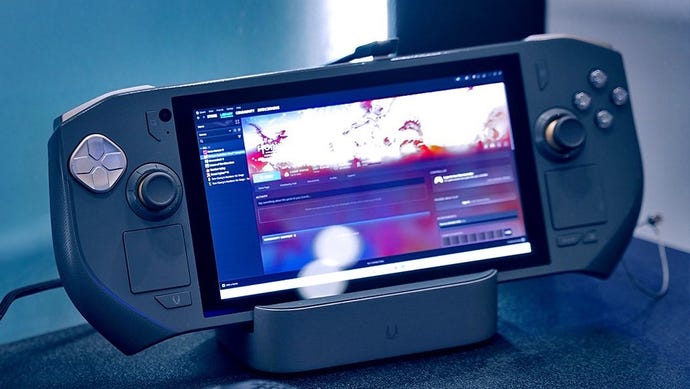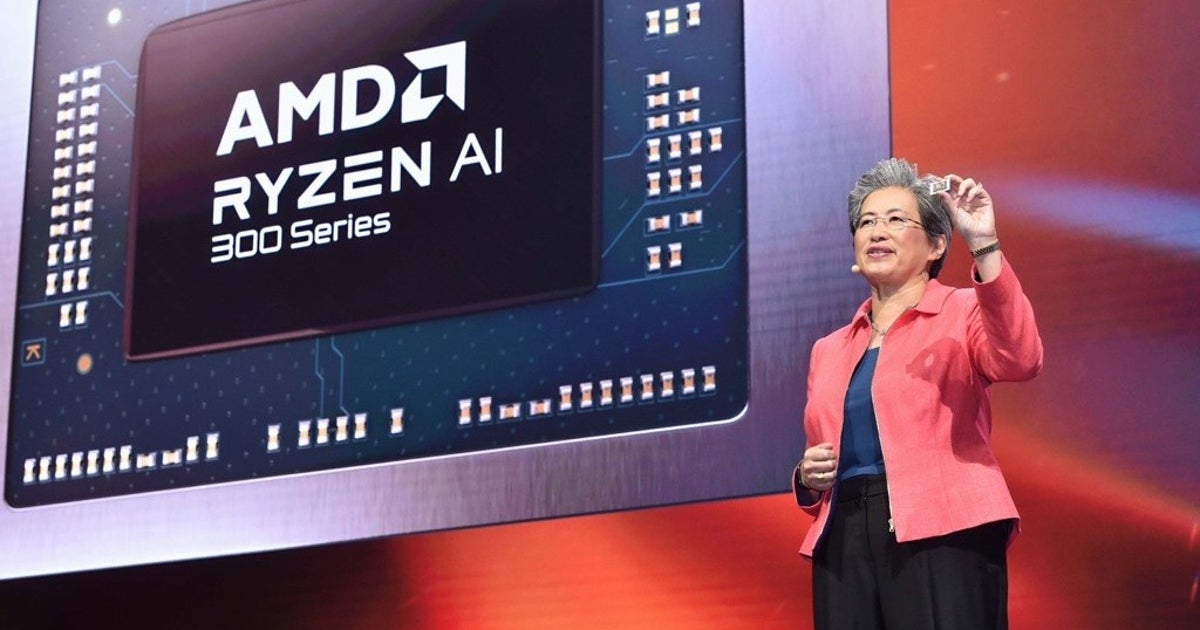Taipei’s annual Computex event is always a big, circled, triple-underlined mark in the PC gaming hardware calendar. Whereas CES splits its focus across tech, cars, and the occasional overdesigned white good, Computex is all computing, all the time, making it a prime source of reveals and showcases for the hardware bits that make games happen.
Sadly, Computex 2024 is unlikely to go down as a classic, largely because this year’s show has been mesmerised by AI and the most tedious applications thereof: search, but different somehow! Run art-stealing generation tools faster! Oh, Computex, what have they done to you, and why do you have seven fingers on one hand?
Granted, AI is a broad field, and not everything about it is necessarily gross or creatively bankrupting. But it also doesn’t deserve to overshadow all the other useful, unexpected, and curiosity-piquing gaming tech that Computex has to offer, from new Steam Deck alternatives to resurrected CPU lineups and promising graphics card updates. Here are those highlights of the show so far…
Nvidia Project G-Assist puts game guides in your games, guys
Nvidia’s gaming AI pursuits range from the brilliant (DLSS) to the sinister (robotic NPCs plying me with drink). The latest, Project G-Assist, at least has the potential to land at the more benevolent end of that scale. It’s a combination of tools that, in short, can provide you with dynamically generated game guides and tips, based on text or speech prompts and delivered in-game via an overlay. G-Assist even promises to take into account what’s appearing/happening onscreen at a given moment – in Nvidia’s demo video, the player simply looks at a dinosaur in Ark: Survival Ascended, asks “How do I tame it?,” and receives a dino-specific answer.
G-Assist appears to have some technical knowledge too, as the same demo shows it offering some optimal quality settings or overclocking options for better game performance – so Ollie, Kiera, and Jeremy can take comfort in knowing that it might put me out of a job as well. That aside, I don’t feel nearly as icky about this as with a lot of other AI endeavours. The “Knowledge Database” from which responses are drawn supposedly come from each game’s developers, not unduly scraped from third-party creators, and there’s all kinds of convenience and accessibility benefits to having guides readily available in-game. The reliability of dynamically-generated answers remains suspect, though – see Google’s newly-launched AI helper suggesting we all eat more rocks.
No word yet on G-Assist’s availability, but you can probably expect to see it supported in both Ark and Cyberpunk 2077, the two games featured in the demo.
The Asus ROG Ally X ups the battery, RAM, storage, and price

Once leaked, now confirmed for a July 22nd release, the Asus ROG Ally X aims to target some of the original ROG Ally’s weak points and serve up a refreshed gaming handheld that can more effectively butt heads with the Steam Deck OLED. Unlike Valve’s updated effort, the ROG Ally X leaves the display and APU unchanged, instead aiming to beef up the Ally’s previous spluttering stamina with a double-size 80Whr battery. Performance could still get a small boost via the upgraded RAM, which jumps from 16GB of LPDDR5 to 24GB of LPDDR5X, and the default SSD capacity has also (roughly) doubled, to 1TB. Unusually for a Deck-like handheld, this is also now a full-size M.2 2280 drive of the kind you might find in your desktop PC, which should make sourcing an upgrade easier.
But at what cost? Despite some other design improvements, like the replacement of Asus’ in-house GPU enclosure connector with a more universal Thunderbolt 4 port, the ROG Ally X is ultimately both thicker and heavier than the Ally. It’s also a bloomin’ load more expensive: £799 / $800, more than a top-spec Lenovo Legion Go and without that device’s 1440p screen, detachable controller funkiness, or integrated trackpad. Maybe the new battery can work wonders, but it’s going to be a big ask to tempt punters to the Ally X when they can pick up the original model from just £499 / $399. Or a 1TB Steam Deck OLED for £569 / $649.
Intel Battlemage lives, even if Lunar Lake CPUs are the stars of the show

Intel’s keynote focused on Lunar Lake, the next generation of Core laptop CPUs. These do sound pretty swish – instead of being paired with the usual set of RAM sticks, all the system memory is built into the chip itself, like a mobile SoC design. This should make for some tasty efficiency gains, while graphics get a boost from Lunar Lake’s Xe2 GPU architecture.
Intriguingly, spokesman Tom Petersen announced that Xe2 would also form the basis of Battlemage, Intel’s next family of desktop graphics cards. One that’s seen such a long development, peppered with rumours of design and production trouble, that it’s often sounded like the follow-ups to Arc Alchemist’s GPUs might not ever come to fruition. Intel’s Computex show was indeed about Lunar Lake, first and foremost, but that’s a very encouraging sign that Battlemage cards are still in the works. Delayed or not, I’ll be looking out for these – Alchemist cards like the Arc A750 overcame wobbly launches to become genuinely viable GPUs for budget gaming PC builds, at a time when Nvidia and AMD had all but abandoned the entry-level market.
AMD reveals new Ryzen 9000 and Ryzen 5000 CPUs, and that’s not a typo

AMD rarely pass up an opportunity to announce a new BESTEST MOST POWERFUL GAMING CPU EVER, and this time it was the Ryzen 9 9950X, the vanguard of its new, Zen 5 architecture-powered Ryzen 9000 series. Here are the models and specs confirmed during AMD’s Computex event; no pricing yet, but they’ll be out in July.
| Model | Cores/Threads | Max Boost clock speed | Total cache | TDP |
|---|---|---|---|---|
| Ryzen 9 9950X | 16/32 | 5.7GHz | 80MB | 170W |
| Ryzen 9 9900X | 12/24 | 5.6GHz | 76MB | 120W |
| Ryzen 7 9700X | 8/16 | 5.5GHz | 40MB | 65W |
| Ryzen 5 9600X | 6/12 | 5.4GHz | 38MB | 65W |
While I’m sure the Ryzen 9 9950X will find a home in plenty of top-spec rigs, personally I’ve got my eye on that Ryzen 7 9700X. Eight cores and only 200MHz behind the flagship chip, while eating up just 65W? Yum. However, AMD also had a more surprising reveal for those on limited upgrade budgets, in the form of the Ryzen 9 5900XT Ryzen 7 5800XT. Yes, new Ryzen 5000 chips, nearly four years on from the series’ first.
| Model | Cores/Threads | Max Boost clock speed | Total cache | TDP |
|---|---|---|---|---|
| Ryzen 9 5900XT | 16/32 | 4.8GHz | 72MB | 105W |
| Ryzen 7 5800XT | 8/16 | 4.8GHz | 36MB | 105W |
AMD haven’t just huffed too much silicon dust, mind – the idea is that since these fit the old AM4 socket, not the AM5 design used by the Ryzen 9000, they fill a niche for anyone who fancies more processing power but doesn’t want to gut their entire AM4 system by replacing the motherboard as well. Which is fair enough. Again, no pricing as of yet, but both 5000 chips will be out soon.
The Zotac Zone is the most Steam Deck-looking Steam Deck rival yet

At last, someone has made a Steam Deck-style portable PC that borrows one of its most underrated features: the dual trackpads. As such, the Zotac Zone closely resembles Valve’s device, even if it is an altogether different beast in most other respects.
Thanks to some sneaky show floor photography by OKestGamer, we can see that the Zone goes for a 7in OLED display, but its 1080p resolution and 120Hz refresh rate are respectively sharper and faster than the Steam Deck OLED’s 800p/90Hz panel. It also packs in Hall Effect joysticks, dual-stage triggers buttons, and an AMD Ryzen 7 8840U APU. While I haven’t used anything with this chip myself, we know from the existing laptops it powers that it can do at least 30fps in most AAA games. It also seems to run Windows 11, which is where those trackpads will come in especially handy – as the ROG Ally has shown, it’s not the kind of OS that plays particularly nicely with touchscreen and thumbstick controls alone.
Like the ROG Ally X, though, you might have to fork over some serious stacks for these specs. In lieu of any official confirmation, Spanish site Geeknetic reports that the Zotac Zone will launch in September at a cool $800, putting it well above the Deck OLED on pricing.
The MSI Claw 8 AI+ is a record-time replacement for the troubled original

Remember the MSI Claw? Just three months after this unusually Intel-based handheld PC launched to iffy reviews, MSI are seeking a do-over with the Claw 8 AI+. This swaps the Meteor Lake chip of the original model for one of Intel’s literally-just-announced Lunar Lake chips (see above), promising significant graphical performance upgrades by way of that Xe2 GPU. The 120Hz display is also growing from 7in to 8in, and to help with the added power strain, the battery is doing a ROG Ally X and swelling up to 80Whr.
Asa much as Intel han handhelds remain a novel concept, I’m not quite as “Ooh, gimme” about this than I am about the Ally X (or indeed the Zotac Zone), mainly because I fear these upgrades will come at the expense of something else the Claw needed: a price cut. Availability details remain TBC for now, so we’ll see. You could also say that unveiling a successor so soon after the original is a bit of a kick in the teeth to those who bought the first Claw, though since the Claw 8 AI+ exists at all… I’m guessing not many did?

